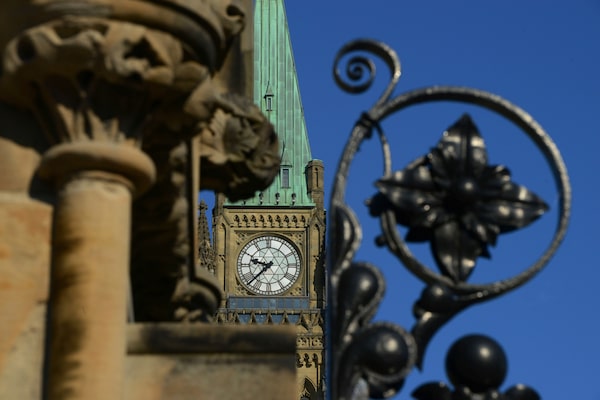
The Peace Tower is seen on Parliament Hill, in Ottawa, in a file photo.Sean Kilpatrick/The Canadian Press
A new report by the Parliamentary Budget Officer says this year’s federal deficit could exceed $252.1-billion, but Prime Minister Justin Trudeau said he doesn’t expect the federal government will need to take exceptional measures to manage the billions in new debt created during the COVID-19 pandemic.
The $252.1-billion price tag represents 12.7 per cent of Canada’s GDP. The report by Parliamentary Budget Officer Yves Giroux cautions that the figures are an illustrative scenario of what could happen and are not a forecast of the most likely outcome.
His report also notes the size of the deficit could rise further if the government chooses to extend any of its short-term emergency programs or if the government approves new spending to stimulate the economy once most businesses are allowed to open.
The government’s December fiscal update, which was released before the pandemic, projected a $28.1-billion deficit for 2020-21.
Under the PBO’s scenario, the federal debt-to-GDP ratio would rise from 30.8 per cent to 48.4 per cent in the 2020-21 fiscal year, a level not seen since 1999-2000. The report points out that such a level would still be below the peak of 66.6 per cent of GDP reached in 1995-96.
During his daily news conference, Mr. Trudeau declined to speculate on the government’s future plans for stimulus measures or options for managing the new debt.
Mr. Trudeau was asked specifically whether the federal government will eventually need to raise taxes in order to deal with the fiscal consequences of the pandemic response.
“We’re not thinking about that at all right now," he answered in French. “We have great confidence in the economy recovery and in the ability of Canadians to resume economic activity and to prosper. We’ve seen this for many years. Our economy’s fundamentals remain very strong despite this crisis. All countries are facing great difficulties economically. Canada started this crisis with a better debt-to-GDP ratio than many of our partners and we are going to be able to get out of this crisis, I hope, in a better position than other countries. And we shouldn’t have to take any exceptional measures.”
Finance Minister Bill Morneau shelved plans to release a federal budget on March 30 and no new date has been announced. The federal government has not provided its own estimate of how the pandemic and Ottawa’s policy response will affect its bottom line.
Prior to the pandemic, Mr. Morneau had been planning to release a budget focused heavily on implementing the Liberal Party’s many environmental promises made during the 2019 campaign.
This week, some leading figures in international finance, including International Monetary Fund Managing Director Kristalina Georgieva, called for global stimulus policies to focus on a “green recovery” centred on climate change.
The PBO, a non-partisan office that reports to Parliament, has repeatedly revised its deficit forecasts as the government rolled out more policy measures and as the economic forecasts related to the fallout of the pandemic worsened.
In a March 27 report, the PBO said the 2020-21 deficit could be $112.7-billion, and on April 9 it said the deficit could be $184.2-billion.
The government’s most recent cost breakdown of measures announced in response to COVID-19 shows it has provided $145.6-billion in direct program spending, $85-billion in tax deferrals and $586.4-billion in liquidity support measures.
Prior to the pandemic, the PBO had said federal finances were in a fiscally sustainable position and that the federal debt-to-GDP ratio was on track to decline over time. The PBO had warned, however, that provincial finances as a whole were not sustainable.
In Thursday’s report, the PBO said the future direction of the federal debt-to-GDP ratio will depend on how quickly the current emergency spending programs are unwound.
“Once the budgetary measures expire and the economy recovers, the federal debt-to-GDP ratio should stabilize and then start declining under pre-crisis fiscal policy settings,” the PBO report states. “However, should some of the measures be extended or made permanent, the federal debt ratio could keep rising.”
Conservative finance critic Pierre Poilievre said it is “astounding” that the deficit estimate is at such a level just one month into the current fiscal year.
“These staggering deficits are a reminder that we should have saved up and paid down debt in the good times to buffer ourselves against the bad times,” he said in a statement. "The only way forward is to get our workers and businesses back as soon as safely possible.”
Your time is valuable. Have the Top Business Headlines newsletter conveniently delivered to your inbox in the morning or evening. Sign up today.
 Bill Curry
Bill Curry